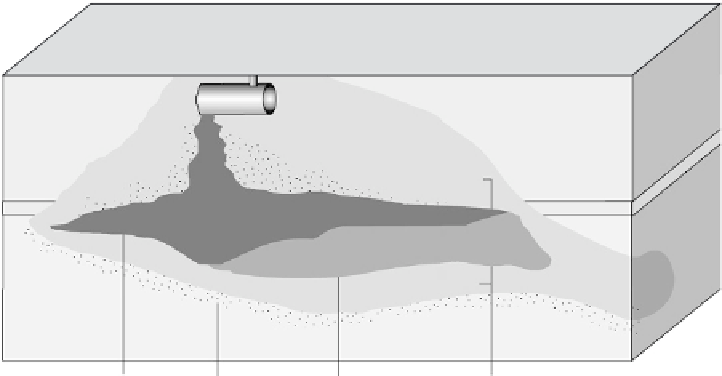Environmental Engineering Reference
In-Depth Information
infiltration
unsaturated
zone
capillary
zone
volatization
and diffusion
water
table
saturated
zone
non aqueous
phase fuel
dilution
anaerobic
biodegradation
aerobic
biodegradation
Figure 5.30.
natural attenuation processes.
Source
: U.S. Geological Survey (2005).
wall construction. Slurry wall construction is limited
to the depths that the trench can be constructed.
Grout curtains
are constructed by injecting grout (liquid,
slurry, or emulsion) into the ground through well points.
Grout penetration varies from site to site but can be
relatively small, requiring closely spaced injection
holes: for example, every 1.5 m (5 ft). Groundwater
flow is impeded by the grout that solidifies in the
interstitial pore space, and the curtain is made contigu-
ous by injecting grout in two or three staggered rows to
ensure a more or less continuous barrier. most grouts
can be injected only in materials with sand-sized and
larger grain sizes. The expense of grouting and the
potential for contamination-related problems in the
grout limit its usefulness.
Sheet piling
involves driving
interlocking sections of steel sheets into the ground. The
piles are typically driven through the aquifer and down
into the consolidated zone using a pile driver. Sheet
piling may be less effective in coarse, dense material
because the interlocking web may be disrupted during
construction.
Groundwater contained within cutoff walls can either
be permanently isolated by a wall around the contami-
nated area and an impervious cap, or the contaminated
groundwater can be pumped from the upgradient side
of the cutoff wall, treated, and injected into the ground-
water on the downgradient side of the cutoff wall. The
most effective approach is usually determined by eco-
nomic considerations.
toxicity, mobility, volume, or concentration of contami-
nants in soil or groundwater. Conceptual illustration of
the important natural attenuation processes that affect
the fate of petroleum hydrocarbons in aquifers is shown
in Figure 5.30. natural attenuation includes processes
such as dispersion, sorption, degradation (either biodeg-
radation or abiotic processes such as hydrolysis), vola-
tization, and other natural processes that affect the
concentration of dissolved contaminants in groundwa-
ter. Volatization is relatively unimportant in most aqui-
fers, except in situations where the water table is less
than 5 m (15 ft) below the ground surface, and the
vadose zone consists of highly transmissive soils. Abiotic
chemical transformations, including hydrolysis and
elimination reactions, are not important processes for
petroleum hydrocarbons but may be significant for
certain chlorinated organic compounds. Biodegradation
is usually the most important process in the natural
removal of petroleum hydrocarbons and chlorinated
solvents from groundwater. In many cases, the feasibil-
ity of adopting a natural attenuation strategy in the
saturated zone depends on whether the regulatory goal
is to clean up the plume to drinking-water standards, or
whether less-stringent risk-based goals are applicable,
such as preventing the plume from expanding.
PROBLEMS
5.1.
Orange trees can tolerate water in the root
zone with a TDS concentration of up to 500 mg/L,
and orange trees require 15 cm of water to
support growth during the spring planting season.
5.8.2.10 Natural Attenuation.
natural attenuation
includes physical, chemical, and biological processes
that act without human intervention to reduce the mass,































Search WWH ::

Custom Search